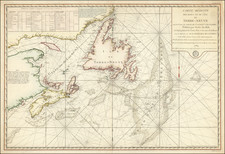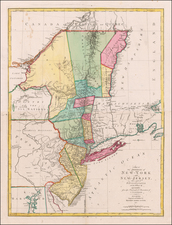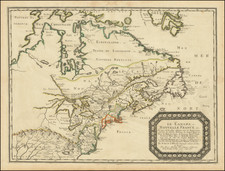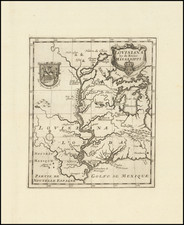Rare separately issued map of the Great Lakes, Michigan, Indiana, Ohio and contiguous parts of the Canada and the Northeast.
This is perhaps the earliest map of the War of 1812 and the first regional map to show Michigan Territory (all prior maps being of the entire U.S. or larger regions). The map is also the only War of 1812 map to have appeared in the Streeter sale. It covers the area of conflict along the U.S. and Canadian border, showing forts on the U.S. side and a great deal of detail on Canadian townships with a separate listing of towns in the various districts.
The present example is a variant edition of the map. Karpinski describes an example which also lists Amos Doolittle in New Haven as the engraver. We note that there are two varying descriptions of the engraver credit line, one noting that the map is "Engraved by T. Kensett, Cheshire & A. Doolittle, New-Haven" (this edition is held by John Carter Brown Library, Connecticut Historical Society and Connecticut State Library) and a second noting that it is "Engraved by: A. Doolittle, New Haven and T. Kensett, Cheshire Connect" (Clements Library) (Note that these entries are based upon catalog descriptions and not a physical inspection of the map).
Amos Doolittle was working in New Haven during the period of Thomas Kensett's residency. The firm of Shelton & Kensett is known to have reworked and relettered an engraved bust of George Washington after Gilbert Stuart, which appeared in the Connecticut Magazine, or Gentleman's and Lady's Monthly Museum (January, 1801), but we have not found any other evidence of their collaboration.
Thomas Kensett (1786-1829) began his career in England as an Engraver at Hampton Court. By 1806, he had moved to America, where his earliest engraved map (a copy of the Wadsworth plan of New Haven) was published. He later became a member of the firm of Shelton & Kensett, engravers and publishers, in Cheshire, Connecticut. By 1825, he had moved to New York City, where he and his uncle, Robert Daggett, would go on to obtain an early patent for storing food in tin cans. Thomas's son John Frederick Kensett (born 1816) began his working career as an engraver in the family shop. By 1829, at age 13, John had moved to New York, where he worked with Peter Maverick, then one of America's most famous printers. John Kensett would go on to become one of America's most important 19th-century landscape painters. Deeply influenced by the aims and technique of Hudson River School founder Thomas Cole, Kensett is viewed as an heir to Cole in his leadership of the Hudson River tradition.










![[ Michigan & 3 Great Lakes ] Amer. Sep. No. 42 Haut Canada Et Michigan](https://storage.googleapis.com/raremaps/img/small/98409.jpg)
![Carte Du Canada ou de la Nouvelle France et des Decouvertes qui y ont ete faites . . . [Map of Canada or New France and the Discoveries Made Therein . . .]](https://storage.googleapis.com/raremaps/img/small/94450.jpg)


